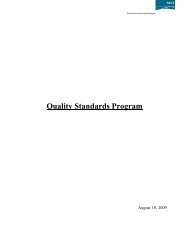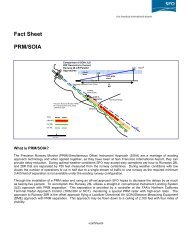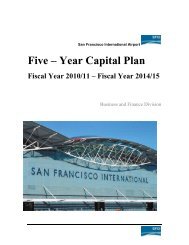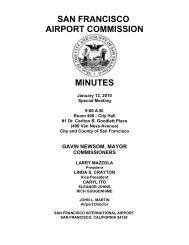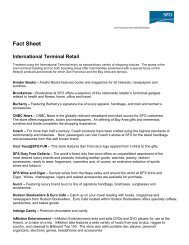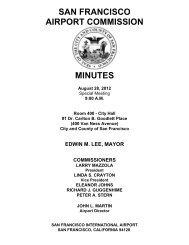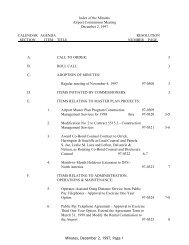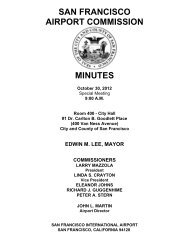Official Statement Airport Commission City and County of San ...
Official Statement Airport Commission City and County of San ...
Official Statement Airport Commission City and County of San ...
Create successful ePaper yourself
Turn your PDF publications into a flip-book with our unique Google optimized e-Paper software.
<strong>and</strong> management <strong>of</strong> the Fuel System is performed by a third-party pursuant to an operation <strong>and</strong> management<br />
agreement with SFO Fuel.<br />
The Fuel System currently includes a pipeline system, with a loop around the Terminal Complex which<br />
provides redundancy in the event <strong>of</strong> a pipeline break; various hydrant systems, some <strong>of</strong> which are leased to SFO<br />
Fuel; storage tanks owned by the <strong>Airport</strong> <strong>and</strong> leased to SFO Fuel, with total storage capacity <strong>of</strong> approximately<br />
132,500 total usable barrels (representing approximately 2.4 days <strong>of</strong> operations based upon 2009 consumption);<br />
above-ground storage tanks owned by SFO Fuel, operated by Chevron Corporation (“Chevron”) <strong>and</strong> located on<br />
ground sublet from SFO Fuel pursuant to a tank farm sublease (the “SFO Fuel/Chevron Tank Farm”), with total<br />
storage capacity <strong>of</strong> approximately 104,000 usable barrels (representing approximately 1.9 days <strong>of</strong> operations based<br />
upon 2009 consumption); <strong>and</strong> other related facilities. The Chevron tanks are operated <strong>and</strong> maintained by Chevron.<br />
SFO Fuel <strong>and</strong> Chevron recently reported to the EPA that there was inadequate emergency fuel storage<br />
secondary containment at the SFO Fuel/Chevron Tank Farm <strong>and</strong> therefore, it was out <strong>of</strong> compliance with provisions<br />
<strong>of</strong> the Clean Water Act that requires aboveground petroleum storage facilities have secondary containment <strong>of</strong> at<br />
least the volume <strong>of</strong> the largest tank, in this case 90,000 barrels plus various miscellaneous regulated adjustments.<br />
There have not been any spills or releases <strong>of</strong> fuel at the SFO Fuel/Chevron Tank Farm. In response, SFO Fuel<br />
<strong>and</strong> Chevron reduced the amount <strong>of</strong> fuel being stored in the tanks to the volume that the current emergency system<br />
can contain. SFO Fuel <strong>and</strong> Chevron are spending approximately $1 million to enhance secondary containment at<br />
the SFO Fuel/Chevron Tank Farm in the unlikely event <strong>of</strong> a spill, <strong>and</strong> expect to spend an additional $2 million on<br />
geosynthetic clay lining to protect a leak within the facility from absorbing into the earth <strong>and</strong> contaminating<br />
groundwater. The costs <strong>of</strong> this project will be paid by for SFO Fuel/Chevron not by the <strong>Airport</strong>.<br />
In early 2007, SFO Fuel finalized an arrangement with an affiliate <strong>of</strong> Shell Oil for substantial additional<br />
<strong>of</strong>f-<strong>Airport</strong> jet fuel storage at facilities immediately adjacent to the <strong>Airport</strong>. The total storage capacity at the Shell<br />
Oil facilities is approximately 186,000 total barrels (representing approximately 3.3 days <strong>of</strong> operations based on<br />
2009 consumption). In addition, SFO Fuel has entered into other agreements for <strong>of</strong>f-<strong>Airport</strong> jet fuel terminaling,<br />
storage, <strong>and</strong> transportation for the benefit <strong>of</strong> SFO Fuel members <strong>and</strong> to further supplement its on-<strong>Airport</strong> facilities.<br />
SFO Fuel may elect in the future to construct additional significant on-<strong>Airport</strong> jet fuel storage <strong>and</strong> related facilities,<br />
but has no current plans to do so.<br />
Communications Facilities<br />
The <strong>Airport</strong> operates state-<strong>of</strong>-the-art telecommunications facilities at the ITC. The <strong>Airport</strong> was the first<br />
airport in the United States to <strong>of</strong>fer its tenants separate broadb<strong>and</strong> services from two local service carriers: Pacific<br />
Bell <strong>and</strong> AT&T Local Services, each <strong>of</strong> which provides the <strong>Airport</strong> with OC-48 Synchronous Optical Network<br />
(“SONET”) rings that deliver diverse, redundant, <strong>and</strong> continuous services to <strong>Airport</strong> users. The <strong>Airport</strong> operates a<br />
Gigabyte Ethernet Network that supports an extensive array <strong>of</strong> Common-Use Terminal Equipment in the ITC. The<br />
CUTE design allows airlines to operate from any service counter in the ITC as well as in their individual <strong>of</strong>fices.<br />
The <strong>Airport</strong> has also implemented a contingency communications system for use when catastrophic or<br />
other events disable st<strong>and</strong>ard communications systems. This contingency system permits the <strong>Airport</strong> to deploy a<br />
network <strong>of</strong> wireless services, including cellular telephones <strong>and</strong> pagers. In addition, the <strong>Airport</strong> has the capability to<br />
manually perform passenger processing <strong>and</strong> baggage transport in the event <strong>of</strong> emergencies.<br />
Through a concessionaire, T-Mobile, the <strong>Airport</strong> installed a high-speed wireless broadb<strong>and</strong> network<br />
(also known as “Wi-Fi”) for use by passengers, tenants, the Transportation Security Administration (the “TSA”) <strong>and</strong><br />
the <strong>Commission</strong>.<br />
BART Extension to SFO<br />
The <strong>San</strong> Francisco Bay Area Rapid Transit (“BART”) extension to the <strong>Airport</strong> opened for full operation on<br />
June 22, 2003. The extension creates a convenient connection between the <strong>Airport</strong> <strong>and</strong> the greater <strong>San</strong> Francisco<br />
Bay Area that is served by BART. According to BART statistics for Fiscal Year 2007-08, a weekday average <strong>of</strong><br />
4,859 riders exited at the SFO BART station. An intermodal station in the <strong>City</strong> <strong>of</strong> Millbrae provides a direct link<br />
between BART <strong>and</strong> CalTrain <strong>of</strong>fering additional transit options <strong>and</strong> connection to the southern parts <strong>of</strong> the Bay Area<br />
as well as <strong>San</strong> Francisco. In order to close an approximately $250 million four-year deficit, effective July 1, 2009,<br />
BART increased fares by 6.1% <strong>and</strong> increased the one-way surcharge levied on riders using the station at the <strong>Airport</strong><br />
39



